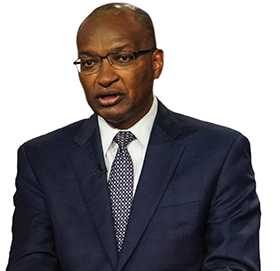After registering its best performance in five years in 2018, Kenya’s economic growth has cooled somewhat in 2019. In its World Economic Outlook for October, the International Monetary Fund (IMF) forecast gross domestic product (GDP) growth of 5.6% for 2019, down from 6.3% in 2018. The lower figure reflects the impact of a regional drought on the country’s agricultural sector, together with the knock-on effect from international trade tensions on emerging economies more generally.
Such growth prospects, however, remain significantly higher than the 3.2% average forecast for sub-Saharan Africa. Despite Kenya’s woes this year, its growth is forecast by the IMF to recover to 6% in 2020, thanks to a well-diversified economy. The country has significant import cover, while both fiscal and current account deficits are reducing.
Debt worries
Nevertheless, Kenya faces challenges – not least its high debt levels. Debt hit 60% of GDP in June 2019, thanks in no small part to a $2.1bn Eurobond issue in May, following a debt-fuelled infrastructure spending spree since 2013.
Local analysts suggest that debt repayments will account for one-third of government revenues in Kenya in 2019, one of the highest ratios in Africa. Moody’s reported in July that a reported rise in the government’s arrears to domestic goods and service providers had begun to weigh on domestic manufacturers. Non-performing loans have begun rising in recent years, “a trend that can be indicative of accumulated arrears by the government to domestic suppliers”, the agency said.
“Domestic liquidity pressures in Kenya are intensifying, but yields remain stable for now,” says Lucie Villa, vice-president, senior credit officer at rating agency Moody’s. “Kenya's credit profile is increasingly vulnerable to any deterioration in the banking sector or adverse market sentiment.”
Also controversial is an interest rate cap introduced by the Central Bank of Kenya (CBK) in 2016, restricting the levels at which banks can lend. The move, designed to spur lending to the private sector, had the opposite effect, with banks proving increasingly reluctant to lend to small and medium-sized enterprises in particular. “Banks have also shifted their asset mix in favour of government securities, which offer attractive yields relative to their lower risk, and carry a capital benefit,” said Fitch Ratings in a September report. “Gross loans grew by only 5% on average for Kenya’s eight largest banks in 2018, compared with 6% in 2017, 7% in 2016 and 17% in 2015.”
In mid-October, Kenyan president Uhuru Kenyatta rejected 2019/20 budget measures retaining the cap. As The Banker went to press, Kenya’s parliament was due to meet to discuss the measures. The repeal of the interest rate cap is one of a series of conditions set by the IMF for the renewal of a $1.5bn standby credit facility, which expired in September 2018 and has yet to be renewed.
Patrick Njoroge was appointed as CBK governor in 2015, and was awarded a second term earlier this year. Prior to his current role, he served as an adviser to the deputy managing director of the IMF.
In a conversation with The Banker, edited for clarity and length, Mr Njoroge discussed measures taken by the CBK to improve banks’ customer focus, efforts to reduce debt levels, and the prospects for further consolidation in the Kenyan banking sector.
Q: Kenya's banks have been prohibited since 2016 from charging more than four percentage points above the central bank base rate for loans. When is the cap likely to be revised or removed?
A: In the medium term we know where we are going to be – namely with an interest rate regime where rates are determined by the markets.
The point is that there needs to be other changes as well. One of the reasons for the interest rate cap was a disillusionment among the population about the way the banking sector was behaving and the affordability of loans. People were being priced out by rates at the time.
This was one element that led to the cap. But we’ve also been putting in place a lot of measures to bring deeper change to the banking sector. One thing is to make the sector much more customer-centric. For the first time, we now have a banking sector charter, setting expectations for issues such as how quickly they deal with customer claims and so on. We’ve also encouraged banks to adopt a risk-based approach to pricing loans, which should be the basis for calculating costs.
We’ve made the point that the best outcome is not to have interest rate caps, not just in the future but from today.
Q: What is the status of talks with the IMF regarding the renewal of the $1.5bn standby credit facility? Has the Eurobond issuance of May removed the need for such a facility?
A: Our views regarding engagement with the IMF have not changed. Our interaction with [it] is based on only one principle: that we know there will be [financial] shocks and we want to buy insurance from it before the house is burning.
As to how we proceed with arranging [such a facility] and our discussions with it, we’ve been discussing this with the IMF for some time. These things take time. This is why we’ve made the point that there is no rush.
Q: The IMF claimed in 2018 that the shilling was significantly overvalued. Are you happy with the currency's valuation?
A: Reporting on this subject in the past has often been done with a particular point of view, while we are economists dealing with economic matters rather than politics. Our exchange rate policy is simply to have a flexible exchange rate regime, meaning that we allow the rate to move based on supply and demand in the interbank market. We intervene only to minimise and reduce volatility.
The IMF did its analysis [last year] and came out with the statement that our exchange rate was 17.5% overvalued. That was a shock to everybody apart from the IMF. We made the point that the way it had calculated this was not correct; we used the relevant methodologies and our number was [an overvaluation of] less than 5%, meaning it was well within the margin of error and so nothing to worry about.
If there was an overvaluation by 17.5%, you’d have parallel markets springing up everywhere, and this isn’t the case.
Q: How worried are you about Kenya's debt level?
A: In Kenya, the debt level was about 60% of GDP as of June 2019. This is a gross figure encompassing both public and public-guaranteed debt. A significant amount relates to borrowing for infrastructure that is financed by China, a significant chunk of which relates to railroads.
Recently, the IMF has changed our debt classification from having a low risk of default to a medium risk. We were on the threshold, and then it changed the way it calculated the classifications, and we borrowed a little more. But it doesn’t mean we’ve moved very much.
I think 'worried' may be the wrong word, but I think we should be concerned, and that we should have policies to deal with the situation. The room for debt-financed instruments has narrowed, and that headroom has now vanished. So the country needs to turn to non-debt financing. And we need to work towards bringing the debt level down to a place where we have a comfortable buffer.
It also means looking to partly improve our fiscal position and perhaps thinking about how to refinance some of the debt we have, to make it cheaper. So it is really a package of measures that we’re already starting to think about.
Q: The central bank approved the merger of NIC and Commercial Bank of Africa in late September, after approving KCB’s takeover of the National Bank of Kenya. Is there still scope for further consolidation within the market?
A: Yes, there is still scope, and indeed there are several institutions that are thinking of working towards consolidation and strengthening their business practices to be more resilient by working with others. The bottom line is really what are the banks going to do for consumers, for borrowers, for depositors? It is the business side where the outcome is. It is good to have consolidations, but it is not for nothing they’re consolidating; it is for a different purpose: which is the consumer.













